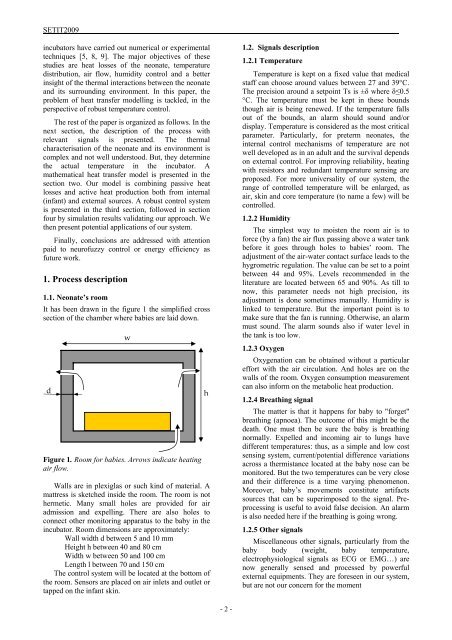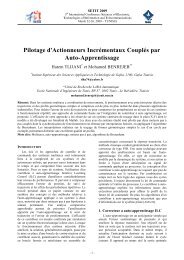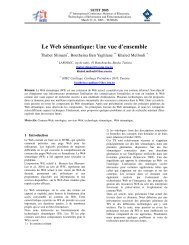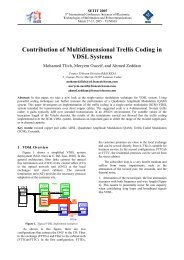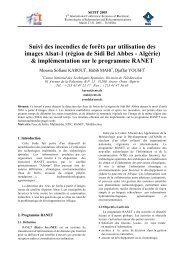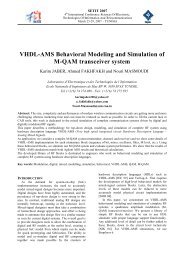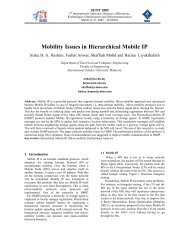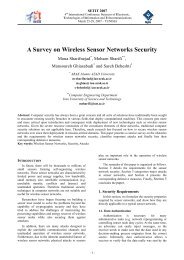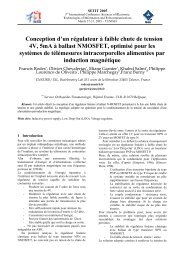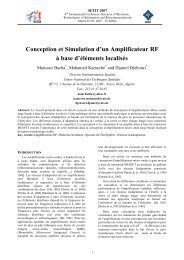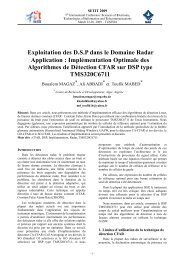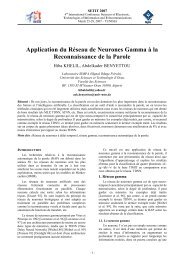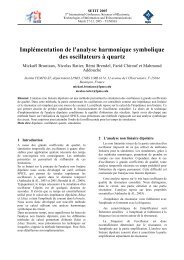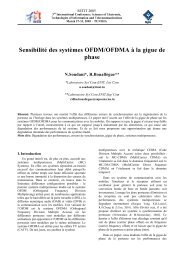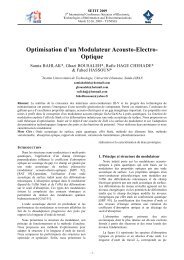Parameters Modelling and Fuzzy Control System of Neonatal ...
Parameters Modelling and Fuzzy Control System of Neonatal ...
Parameters Modelling and Fuzzy Control System of Neonatal ...
You also want an ePaper? Increase the reach of your titles
YUMPU automatically turns print PDFs into web optimized ePapers that Google loves.
SETIT2009<br />
incubators have carried out numerical or experimental<br />
techniques [5, 8, 9]. The major objectives <strong>of</strong> these<br />
studies are heat losses <strong>of</strong> the neonate, temperature<br />
distribution, air flow, humidity control <strong>and</strong> a better<br />
insight <strong>of</strong> the thermal interactions between the neonate<br />
<strong>and</strong> its surrounding environment. In this paper, the<br />
problem <strong>of</strong> heat transfer modelling is tackled, in the<br />
perspective <strong>of</strong> robust temperature control.<br />
The rest <strong>of</strong> the paper is organized as follows. In the<br />
next section, the description <strong>of</strong> the process with<br />
relevant signals is presented. The thermal<br />
characterisation <strong>of</strong> the neonate <strong>and</strong> its environment is<br />
complex <strong>and</strong> not well understood. But, they determine<br />
the actual temperature in the incubator. A<br />
mathematical heat transfer model is presented in the<br />
section two. Our model is combining passive heat<br />
losses <strong>and</strong> active heat production both from internal<br />
(infant) <strong>and</strong> external sources. A robust control system<br />
is presented in the third section, followed in section<br />
four by simulation results validating our approach. We<br />
then present potential applications <strong>of</strong> our system.<br />
Finally, conclusions are addressed with attention<br />
paid to neur<strong>of</strong>uzzy control or energy efficiency as<br />
future work.<br />
1. Process description<br />
1.1. Neonate’s room<br />
It has been drawn in the figure 1 the simplified cross<br />
section <strong>of</strong> the chamber where babies are laid down.<br />
d<br />
w<br />
Figure 1. Room for babies. Arrows indicate heating<br />
air flow.<br />
Walls are in plexiglas or such kind <strong>of</strong> material. A<br />
mattress is sketched inside the room. The room is not<br />
hermetic. Many small holes are provided for air<br />
admission <strong>and</strong> expelling. There are also holes to<br />
connect other monitoring apparatus to the baby in the<br />
incubator. Room dimensions are approximately:<br />
Wall width d between 5 <strong>and</strong> 10 mm<br />
Height h between 40 <strong>and</strong> 80 cm<br />
Width w between 50 <strong>and</strong> 100 cm<br />
Length l between 70 <strong>and</strong> 150 cm<br />
The control system will be located at the bottom <strong>of</strong><br />
the room. Sensors are placed on air inlets <strong>and</strong> outlet or<br />
tapped on the infant skin.<br />
h<br />
1.2. Signals description<br />
1.2.1 Temperature<br />
Temperature is kept on a fixed value that medical<br />
staff can choose around values between 27 <strong>and</strong> 39°C.<br />
The precision around a setpoint Ts is ±δ where δ≤0.5<br />
°C. The temperature must be kept in these bounds<br />
though air is being renewed. If the temperature falls<br />
out <strong>of</strong> the bounds, an alarm should sound <strong>and</strong>/or<br />
display. Temperature is considered as the most critical<br />
parameter. Particularly, for preterm neonates, the<br />
internal control mechanisms <strong>of</strong> temperature are not<br />
well developed as in an adult <strong>and</strong> the survival depends<br />
on external control. For improving reliability, heating<br />
with resistors <strong>and</strong> redundant temperature sensing are<br />
proposed. For more universality <strong>of</strong> our system, the<br />
range <strong>of</strong> controlled temperature will be enlarged, as<br />
air, skin <strong>and</strong> core temperature (to name a few) will be<br />
controlled.<br />
1.2.2 Humidity<br />
The simplest way to moisten the room air is to<br />
force (by a fan) the air flux passing above a water tank<br />
before it goes through holes to babies’ room. The<br />
adjustment <strong>of</strong> the air-water contact surface leads to the<br />
hygrometric regulation. The value can be set to a point<br />
between 44 <strong>and</strong> 95%. Levels recommended in the<br />
literature are located between 65 <strong>and</strong> 90%. As till to<br />
now, this parameter needs not high precision, its<br />
adjustment is done sometimes manually. Humidity is<br />
linked to temperature. But the important point is to<br />
make sure that the fan is running. Otherwise, an alarm<br />
must sound. The alarm sounds also if water level in<br />
the tank is too low.<br />
1.2.3 Oxygen<br />
Oxygenation can be obtained without a particular<br />
effort with the air circulation. And holes are on the<br />
walls <strong>of</strong> the room. Oxygen consumption measurement<br />
can also inform on the metabolic heat production.<br />
1.2.4 Breathing signal<br />
The matter is that it happens for baby to "forget"<br />
breathing (apnoea). The outcome <strong>of</strong> this might be the<br />
death. One must then be sure the baby is breathing<br />
normally. Expelled <strong>and</strong> incoming air to lungs have<br />
different temperatures: thus, as a simple <strong>and</strong> low cost<br />
sensing system, current/potential difference variations<br />
across a thermistance located at the baby nose can be<br />
monitored. But the two temperatures can be very close<br />
<strong>and</strong> their difference is a time varying phenomenon.<br />
Moreover, baby’s movements constitute artifacts<br />
sources that can be superimposed to the signal. Preprocessing<br />
is useful to avoid false decision. An alarm<br />
is also needed here if the breathing is going wrong.<br />
1.2.5 Other signals<br />
Miscellaneous other signals, particularly from the<br />
baby body (weight, baby temperature,<br />
electrophysiological signals as ECG or EMG…) are<br />
now generally sensed <strong>and</strong> processed by powerful<br />
external equipments. They are foreseen in our system,<br />
but are not our concern for the moment<br />
- 2 -


